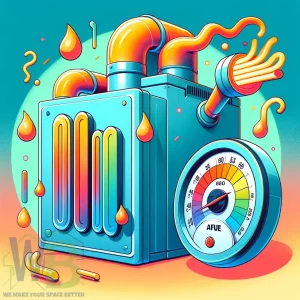In the quest for a more sustainable and efficient home environment, smart thermostats have emerged as a game-changing technology.

Introduction to Smart Thermostats: What They Are and How They Work
Smart thermostats represent a significant leap forward in home climate control technology. Unlike traditional thermostats requiring manual adjustments, smart thermostats bring automation and intelligence to heating and cooling systems. But what exactly are smart thermostats, and how do they function to enhance HVAC efficiency and user comfort?
Defining Smart Thermostats
At their core, smart thermostats are digital, programmable devices that control a home’s heating and air conditioning. They connect to the internet, allowing users to manage home temperatures remotely via smartphones or computers. This connectivity is a cornerstone of their functionality, offering unprecedented control over home climate settings.
Core Features and Functionality
Smart thermostats have various sensors that monitor environmental conditions, such as temperature, humidity, and occupancy. They use this data to adjust settings to optimize comfort and energy efficiency automatically. For instance, a smart thermostat can lower heating or cooling when no one is home, reducing unnecessary energy use.
These devices also learn from user behaviors. Over time, they adapt to your schedule and preferences, automatically creating a heating and cooling program that suits your lifestyle. This learning capability is not just a convenience feature; it’s a critical component in reducing energy consumption and costs.
Remote Access and Control
One of the most appealing features of smart thermostats is their ability to be controlled remotely. Users can adjust temperatures, set schedules, and receive maintenance notifications through a dedicated app. This level of control extends beyond convenience, allowing for precise management of energy usage, even when you’re away from home.
Integration with Smart Home Systems
Smart thermostats seamlessly integrate with broader smart home systems, working with other devices such as smart lights and security systems. This integration enables a holistic approach to home automation, where various elements work together to enhance efficiency, comfort, and security.
The Role of Data and Analytics
Smart thermostats don’t just control your home environment; they provide valuable insights into your energy usage. Through detailed reports and analytics, users can track their heating and cooling patterns, identify areas for improvement, and make informed decisions to optimize energy consumption.
User-Friendly Interfaces
Despite their advanced capabilities, smart thermostats are designed with user-friendliness in mind. Their interfaces are intuitive, often featuring touchscreens and simple navigation. This ease of use ensures that the benefits of smart thermostats are accessible to everyone, regardless of technical expertise.
Smart thermostats are more than just temperature regulators; they are intelligent systems that enhance HVAC efficiency through learning algorithms, remote control, integration with smart home devices, data analytics, and user-friendly interfaces. By understanding their functionality, we can better appreciate their role in revolutionizing home climate control.

The Evolution of HVAC Efficiency: From Manual to Smart Control
The journey of thermostat technology is fascinating, mirroring the advancements in home automation and energy efficiency. Understanding this evolution provides context and highlights the significant improvements that smart thermostats bring to HVAC systems.
The Early Days: Manual Thermostats
The story begins with manual thermostats, the basic yet revolutionary devices that allow homeowners to control indoor temperatures. These early thermostats were simple, often mechanical devices requiring manual adjustment to set the desired temperature. While they provided a previously unavailable control level, they lacked precision and convenience.
The Rise of Programmable Thermostats
As technology progressed, so did thermostat design. Programmable thermostats emerged, allowing preset temperatures for different times of the day. This development marked a step forward in energy efficiency, allowing users to schedule heating and cooling based on occupancy and preference. However, these devices still required a degree of manual input and foresight.
Digital and Wireless Thermostats
The advent of digital technology introduced more user-friendly interfaces and greater accuracy. Digital thermostats provide more apparent displays and more precise temperature control. Introducing wireless thermostats added convenience, eliminating the need for hard-wiring and enabling more flexible installation.
The Smart Thermostat Revolution
The real game-changer in thermostat technology has been the advent of smart thermostats. These devices have transformed the concept of home climate control. Equipped with Wi-Fi connectivity, smart thermostats offer remote control, learning algorithms, and energy usage analytics. They adapt to user behavior, integrate with other smart home devices, and provide insights into energy consumption patterns.
Impact on HVAC Efficiency
This evolution from manual to smart thermostats has significantly impacted HVAC efficiency. Smart thermostats optimize heating and cooling operations, reduce energy wastage, and lower utility bills. They respond to real-time data, making adjustments that manual or even programmable thermostats could never achieve.
The evolution of thermostat technology from manual to smart devices is a testament to the progress in home automation and energy efficiency. Smart thermostats, as the latest in this line, offer unprecedented control and efficiency, marking a new era in home comfort and energy management.

Analyzing the Impact: How Smart Thermostats Save Energy and Money
The introduction of smart thermostats has redefined how we control our home environments and brought significant savings in energy and costs. This section analyzes the tangible impact of smart thermostats on energy consumption and financial savings.
Reduction in Energy Usage
Smart thermostats excel in optimizing home heating and cooling systems, substantially reducing energy usage. They achieve this by learning and adapting to your schedule, adjusting the temperature when you’re away, and ensuring your home is comfortably heated or cooled when you return. This intelligent functionality minimizes unnecessary heating and cooling, directly contributing to energy conservation.
Financial Savings on Utility Bills
One of the most immediate impacts of reduced energy consumption is the decrease in utility bills. Smart thermostats can save homeowners an average of 10-20% on their heating and cooling bills. These savings are not just a one-time benefit but accumulate over time; investing in a smart thermostat is financially prudent.
Environmental Benefits
Besides personal savings, the reduced energy consumption has a broader environmental impact. By using less energy, smart thermostats contribute to lower carbon emissions, aiding the fight against climate change. This eco-friendly aspect is an essential consideration for environmentally conscious consumers.
Tailored Temperature Control
Smart thermostats provide more than just automated temperature control; they offer a customized environment tailored to personal preferences. This tailored approach ensures energy is not wasted on unnecessary heating or cooling, enhancing efficiency and cost-effectiveness.
User Convenience and Enhanced Control
The ability to control and monitor your home’s temperature remotely through a smartphone app adds a layer of convenience that traditional thermostats cannot match. This feature allows users to make real-time adjustments, leading to more efficient energy use and cost savings.
The impact of smart thermostats on energy and cost savings is substantial. By intelligently optimizing heating and cooling, providing personalized temperature control, and offering enhanced user convenience, smart thermostats represent a significant step forward in energy-efficient home management.

User Experience and Comfort: The Adaptive Advantages of Smart Thermostats
The adoption of smart thermostats has brought a significant improvement not just in energy efficiency but also in the overall user experience and comfort. This section explores how these devices adapt to individual needs, enhancing comfort and convenience in our homes.
Personalized Climate Control
One of the most notable benefits of smart thermostats is their ability to create a personalized climate. These devices learn from your preferences and routines, adjusting the temperature to your ideal setting at different times. This customized approach ensures your home is always at the perfect temperature, enhancing comfort and well-being.
Convenience and Ease of Use
Smart thermostats offer unparalleled convenience. With intuitive interfaces and remote control capabilities, adjusting your home’s climate has never been easier. Whether on the couch or away from home, you can manage the temperature with just a few taps on your smartphone.
Enhanced Adaptive Learning
The adaptive learning capabilities of smart thermostats set them apart. They can detect when you’re home, away, or asleep and adjust the temperature accordingly. This smart adaptation ensures optimal comfort and eliminates the need for constant manual adjustments.
Integration with Other Smart Home Devices
Smart thermostats can integrate seamlessly with other smart home devices, like smart lights and security systems, to create a cohesive and intelligent home environment. This integration enhances overall comfort as your home becomes a connected ecosystem that anticipates and caters to your needs.
Real-Time Adjustments for Instant Comfort
Smart thermostats can make real-time adjustments based on external factors like weather changes. If a sudden cold front comes in, your smart thermostat can respond immediately, ensuring your home remains cozy and comfortable.
Smart thermostats offer a transformative user experience by providing personalized climate control, easy operation, adaptive learning, seamless integration with other devices, and real-time adjustments. These features contribute to enhanced comfort and ensure that your home environment is always attuned to your needs.

The Future of Smart Thermostats: Trends and Technological Advancements
As we look ahead, the future of smart thermostats appears promising and transformative, with emerging trends and advancements poised to revolutionize home climate control further.
Integration with Emerging Technologies
The future of smart thermostats lies in their integration with cutting-edge technologies. Developments in artificial intelligence (AI), machine learning, and the Internet of Things (IoT) are set to enhance the functionality of these devices. This integration will lead to smarter, more intuitive systems capable of more precise climate control and energy management.
Enhanced User Interface and Interaction
Advancements in user interface design are expected to make smart thermostats even more accessible and enjoyable to use. Innovations like voice control, gesture recognition, and holographic displays could become standard features, offering users new and exciting ways to interact with their home climate systems.
Predictive Analytics and Proactive Adjustments
Future smart thermostats will likely employ advanced predictive analytics to anticipate user needs and environmental changes. By analyzing vast amounts of data, these devices could proactively adjust settings before the user realizes a change is needed, ensuring optimal comfort and efficiency.
Greater Integration with Renewable Energy Sources
Smart thermostats will increasingly integrate with systems like solar panels and wind energy as the world moves towards renewable energy. This synergy will enable more sustainable and cost-effective home energy management, aligning personal comfort with environmental responsibility.
Customization and Personalization
The next generation of smart thermostats will offer even greater customization and personalization. Users can tailor every aspect of their home climate system to their preferences, from the interface design to the exact temperature settings for different times of the day.
The future of smart thermostats is bright, with technological advancements and emerging trends set to enhance their efficiency, functionality, and user experience. As these devices become more integrated with our lives and other home technologies, they will continue to play a crucial role in shaping the future of home climate control.
Conclusion
The evolution of smart thermostats from simple temperature control devices to sophisticated, AI-powered systems marks a significant advancement in home automation and energy efficiency. By intelligently learning from our habits and preferences, offering remote and voice control, integrating with other smart home technologies, and providing valuable insights into our energy usage, smart thermostats have fundamentally changed how we interact with our home environments.
The impact of these devices extends beyond mere convenience, contributing significantly to energy conservation and cost savings. As we look to the future, the potential for further advancements in this technology promises even greater efficiency and customization, aligning with the global shift towards sustainable living.
In embracing smart thermostats, we are not just optimizing our home comfort and efficiency but participating in a larger movement towards smarter, more responsive, and environmentally conscious living spaces. The journey of smart thermostat technology is a testament to human ingenuity and a preview of the potential of smart home technology to improve our lives.







